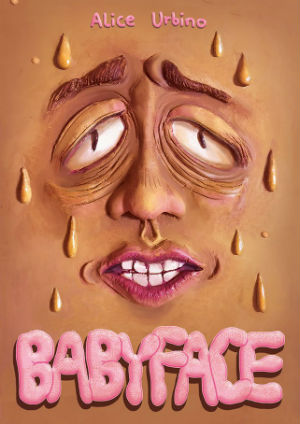 Hot on the heels of her recent minicomic Blindenhund comes Babyface, another enticingly macabre graphic medicine/body horror hybrid comic from the distinctive vision of original Broken Frontier ‘Six Small Press Creators to Watch’ artist Alice Urbino.
Hot on the heels of her recent minicomic Blindenhund comes Babyface, another enticingly macabre graphic medicine/body horror hybrid comic from the distinctive vision of original Broken Frontier ‘Six Small Press Creators to Watch’ artist Alice Urbino.
A little bit of housekeeping to begin with, and the first thing to note about Babyface is that although it is just seeing self-publication in 2019, it was originally created back in 2016 for a project that never came to fruition. Long-term fans of Urbino’s art will notice then that in terms of her evolving style it sits somewhere between the more structured sequential storytelling of her early work and her recent freer-form and experimental approach.
What remains exactly the same though – and has done since I first reviewed her comics in Dimension quite a few years back – is Urbino’s line in deeply affecting allegory and her ability to bring us so deeply into her protagonists’ experiences, reminding us that however bizarre the events she puts her characters through there are nonetheless fundamentally recognisable truths in their predicaments that we instantly identify with.
Behind undoubtedly one of the most striking comics covers of the year, Babyface tells the story of Dew, a young woman born with a vestigial, semi-sentient head on her neck; one that mirrors her own moods, becoming noticeably more agitated and prone to loud wailing whenever she herself is anxious or stressed. Dew keeps this a secret from her classmates by covering her monstrous mini-twin up in public with a scarf. But to her horror her tentative steps into social interaction at a student party leads to her secret being uncovered. It’s a moment of revelation that will introduce her to Laura who has a similar condition on the palm of her hand. But will finding a kindred spirit be a cause for celebration for Dew or end up being something to fear and resent…?
Like much of Urbino’s work Babyface can be interpreted on a number of levels. There’s a surface narrative layer that speaks of obvious themes of discrimination and ableism but as anyone familiar with her practice knows the motifs of her work often have a universal application. Through its insightful accompanying narration Babyface is as much an extended visual metaphor for fitting in and belonging, finding our place, identity and self-acceptance as it is a body horror-style discourse on the perceptions of others.
So many of the strengths of Urbino’s visual storytelling are in evidence here from that almost frenetic visual characterisation that threatens to burst out of the page to her ability to step back from the main narrative with more introspective and representational stream-of-consciousness sequences. While the comic is mostly in black and white, some limited use of colour makes key moments stand out with a dramatic flourish.
The true beauty of an Alice Urbino comic is her ability to present work that is superficially dark and visually grotesque, yet so poignantly human and empathetic at the same time. It is genuinely a quite remarkable quality. In that regard it’s an absolute joy to see her work finally beginning to get the kind of recognition it has always so richly deserved. Those lucky enough to be at TCAF this weekend can experience that firsthand for themselves.
You can buy Babyface from Alice Urbino’s new online store here. Follow her on Twitter here and on Instagram here.
Alice Urbino will be exhibiting at TCAF this coming weekend on the Zineland Terrace.
For regular updates on all things small press follow Andy Oliver on Twitter here.
Review by Andy Oliver

















